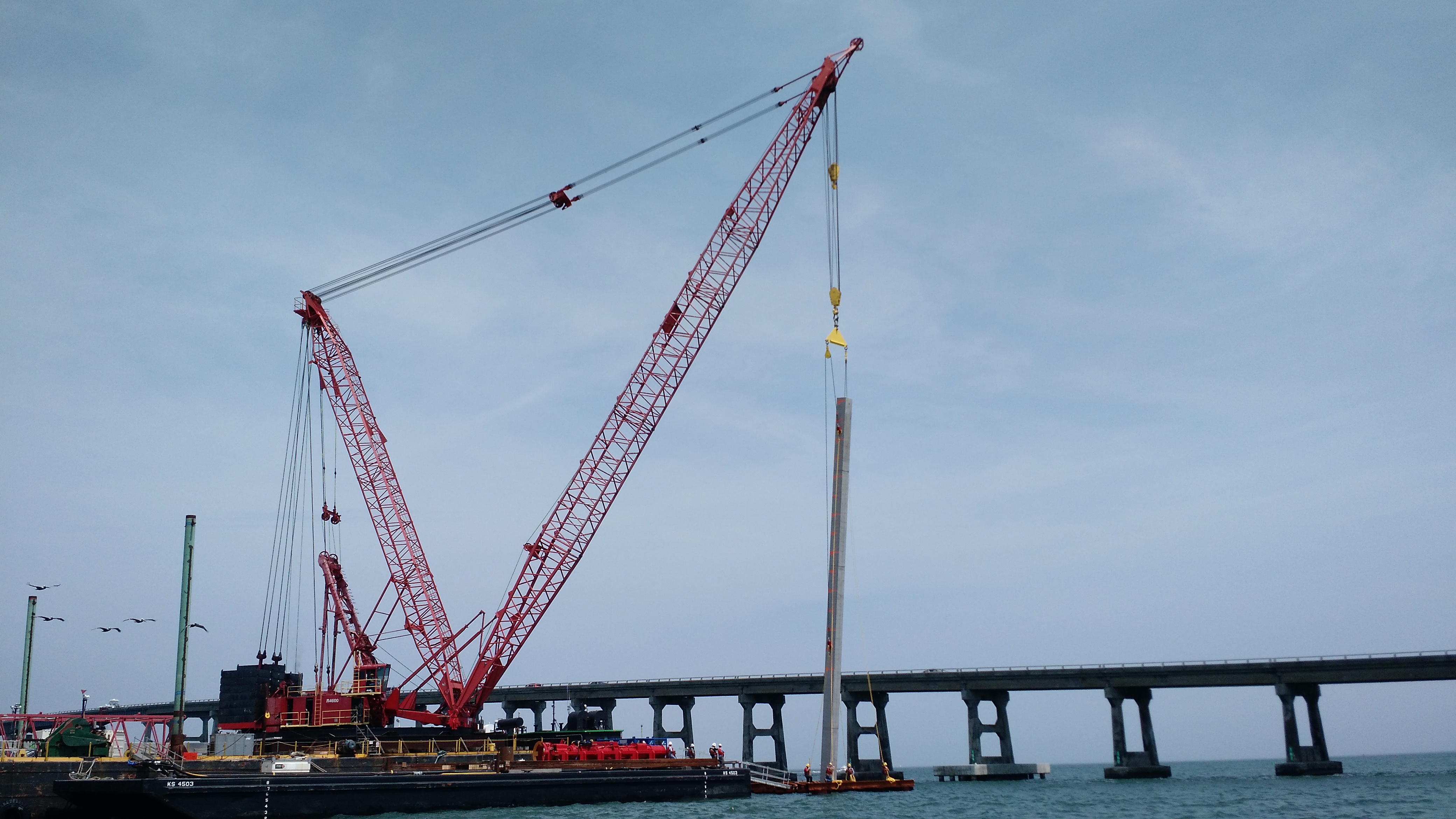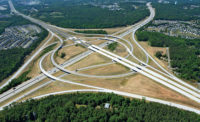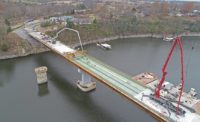Managing infrastructure along North Carolina’s Outer Banks is never easy. Remote, environmentally sensitive and continually reshaped by wind and waves, the course of the thin string of barrier islands is periodically altered by hurricanes and coastal storms. That, in turn, heightens the North Carolina Dept. of Transportation’s ongoing challenge of maintaining State Route 12, the sole highway providing access to villages dependent on beach-based tourism.
Some parts of the Outer Banks are changing faster than others, however, including an increasingly unstable and erosion-prone and overwash-susceptible section of Route 12 known as the “S curves,” just north of the village of Rodanthe. After years of trying to preserve the existing road with sandbag embankments and pavement rebuilds, NCDOT is bypassing the area for good with a $145-million elevated structure currently under construction by the design-build team of Flatiron Construction and RK&K.
Nicknamed the Jug Handle Bridge for its distinctive alignment between Rodanthe and the Pea Island National Wildlife Refuge, the 2.4-mile-long, two-lane structure will form a flattened arc extending approximately 2,000 ft west into Pamlico Sound. Flatiron has been constructing the bridge from both ends since early 2018, with an eye toward completing the project by fall of 2021.
Work on the project was temporarily halted due to the death of a Flatiron employee, Steven R. Bailey, on Aug. 24. A statement from Flatiron Construction noted: “Following this tragic accident, work at the project was suspended while an investigation is underway. Our thoughts are with our employee’s family, friends and colleagues during this difficult time.”
Though the bridge will eliminate the S curves’ long-standing challenges, “solving one problem trades off to another set of problems,” admits Pablo Hernandez, NCDOT district engineer. Among them are the intricacies of building a major structure in water only 2 to 4 ft deep using the smallest practical construction footprint because of the sound’s preponderance of ecologically critical submerged aquatic vegetation.
The alternative of building further west into deeper, more accommodating waters, Hernandez adds, likely would have doubled the project’s size and cost.
Further constraining Flatiron’s construction methods is the design requirement for a robust, 100-year structure capable of handling tropical storms that regularly rake the Outer Banks as well as long-term coastal dynamics that will eventually scour the alignment’s shallow waters to depths of 50 ft or more.
“That meant modeling two bridges in the same place, and finding a balance between flexible and stiff structures for different types of wave action,” says David Peterson, RK&K project manager.
To ensure a firm foundation for the future, the design calls for nearly 300 54-in.-dia cylindrical piles driven 120-130 ft through layers of dense sand to achieve the needed axial and lateral capacity. But with conventional barge-based equipment ruled out due to the shallow, environmentally sensitive location, “we had to look around for a more suitable alternative,” says Adrian Price, Flatiron project manager.
The solution is an innovative advancing rail system that straddles the new bridge as it is being built, saving space while also providing a streamlined construction process. Adapted from similar shallow-water projects on the Gulf Coast and Europe, the 1,600-ft-long system supports the entire bridge-building operation, including the installation of temporary works, pile driving, installation of substructure elements and deck finishing.
Two 70-ton Italian-built gantries operating on separate rail sets handle girder and rebar placement, precast decking installation and material movement. When it’s time to advance the rail system to the next section, a platform-mounted 60-ft crane places rail sections onto a separate trolley for transport forward.
“As soon as concrete comes out of cure and we can put a truck on the deck, we can leapfrog the rail system to the front,” Price says. “This allows us to limit the length of temporary works needed at any one time.”
Battling shallows and salt air
Inching their way into Pamlico Sound in nearly 45-ft increments, Flatiron’s two rail systems are creating a relatively flat 43-ft-wide structure that will keep the bridge deck 25 ft above the water’s surface. The three-pier, cast-in-place bents include a fixed center pier with 1:12 battered side units and topped with cast-in-place pier caps. Spans average 135 ft long, with 45-in. and 72-in. Florida I-beams supporting 5-in.-thick precast deck panels and a 5.5-in.-thick cast-in-place upper deck layer.
Both materials and methods accommodate the corrosive coastal environment in other ways, adapting lessons learned from the recently completed Oregon Inlet bridge replacement just a few miles up the North Carolina coast. For example, bubble curtains minimize underwater noise that can be harmful to aquatic life during pile driving, while concrete placements had to be closely planned and executed. The project will ultimately use 5 million lb of stainless steel for rebar and other exposed metal components.
“Solving one problem trades off to another set of problems.”
– Pablo Hernandez, District Engineer, N.C. Dept. of Transportation
“Whether you’re doing 10 yards or 1,000 yards, you have to minimize salt contamination,” Hernandez says.
Yet another unusual influence on the bridge’s design and construction is a sunken World War II landing craft in the bridge’s path just offshore from Rodanthe. As shipwrecks are a storied part of the history of the Outer Banks, Flatiron committed to avoiding impacts to the vessel even before its historical value had been fully assessed.
“The wreck controls the bent layout of the entire bridge so that we could center a span right across it,” Price says. “We’ve closely monitored the site from the start of construction and crossed it with no problems.”
While construction from Rodanthe has gotten up to speed, the north end has proven more problematic due to more extensive utility relocations and denser soils that have complicated pile-driving efforts. Price says Flatiron is making progress through the area by pre-drilling piles to 50-60 ft.
“The rail system streamlines everything, but you can move only as fast as the slowest operation, which is the deck,” he says. “If we can get the pile driving down to a seven-day cure cycle, we can make up the time.”
Planning for long-distance logistics
Maintaining the rail systems’ operation has required additional logistical planning, particularly with Coastal Precast Systems, supplier of precast components.
“Because of the job’s volume and the unpredictability of things like weather, a just-in-time delivery concept simply wouldn’t work,” explains Ted Holmes, Flatiron’s area operations manager. “If we had to delay a delivery by just a day, the supplier may not have a truck available for the shipment.”
Instead, Flatiron worked with the supplier to secure heavy haul trailers that are delivered full of components for the next phase of work. “As soon as we report that one is empty, they’ll bring down another load and pick up the empty trailer,” Holmes says.
Weather accounts for much of that unpredictability. The same steady winds that attracted the Wright Brothers to the Outer Banks to test their aircraft designs frequently complicate scheduling crane picks for girders, while wave overwash from nor’easters and other coastal storms can temporarily close Route 12 for several hours or more.
“Because of the job’s volume and [other factors], a just-in-time delivery concept simply wouldn’t work.”
– Ted Holmes, Area Operations Manager, Flatiron Construction
So far, the project has had two brushes with full-fledged hurricanes. Dorian’s 90-mph winds in September 2019 forced a two-week shutdown, while Isaias in August idled work for a few days. Processes to secure the site and rail system gantries are based on factors such as the storm’s projected strength and proximity to the area. For tropical storms, preparations focus on securing trash and other items that may become airborne and moving materials onto completed bridge deck sections to protect them from storm surge inundation.
“The line between tropical storm and hurricane strength is where we have to take special measures to secure equipment, such as our cranes, gantries and pile-driving leads,” Price says. “We have engineered hurricane prep plans that show how our specialty equipment must be secured.”
With predictions of above-active hurricane activity in the coming weeks, Flatiron crews will keep an eye on the tropics as the two rail systems work toward their anticipated meeting in the spring of next year.
“Because pile driving is the most challenging aspect of the project, that’s the milestone we’re looking forward to most,” Price says. After completion, Flatiron will spend the next several months on rail-system disassembly while preparing to open the bridge to traffic. After that, Hernandez says, State Route 12’s S curves will be restored to the wildlife refuge and left to nature.
“We’ll remove the roadway and sandbags and restore the land to natural terrain,” he says. “There are no plans for routine maintenance or erosion control.”
Should other nearby portions of Route 12 face similar vulnerability in the coming decades, RK&K’s Peterson says specific spans of the bridge can be adapted into connection points for future extensions. “Eventually, there could be a full viaduct from Oregon Inlet to Rodanthe,” he says.
As with building the Jug Handle Bridge itself, Holmes says, such challenges and change are nothing unusual for the Outer Banks, “though I don’t know if there is a ‘usual’ here.”











Post a comment to this article
Report Abusive Comment